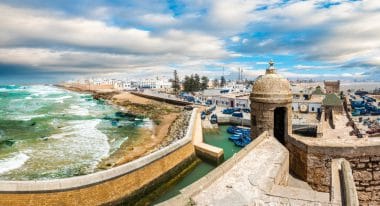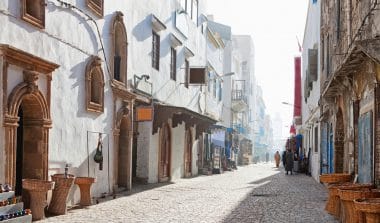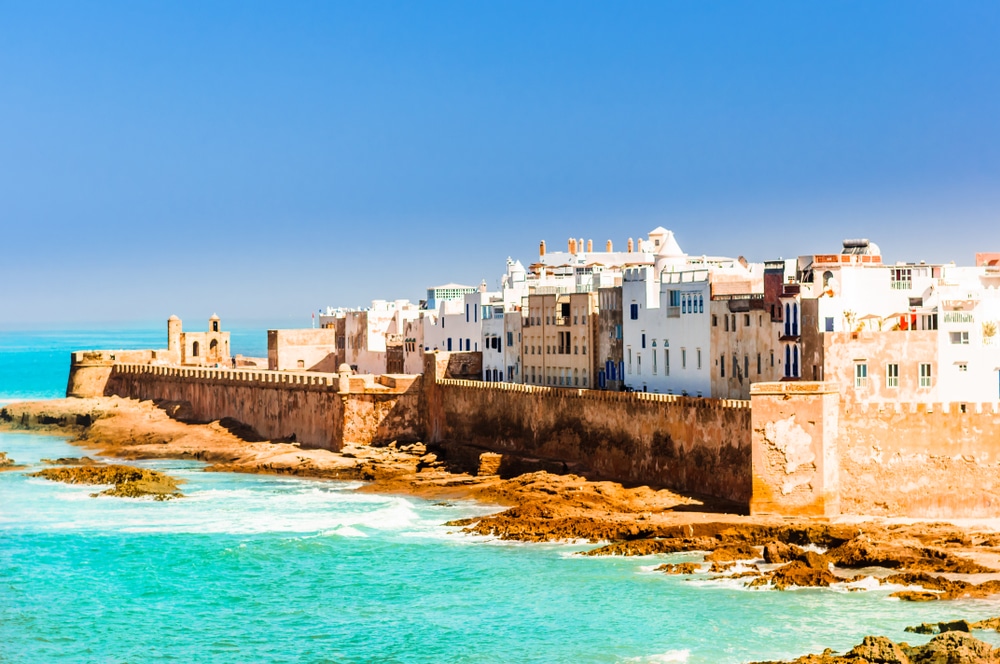Souks and sunsets: Located on Morocco’s Atlantic coast, Essaouira is a mix of North Africa and the Mediterranean. Surrounded by a city wall of golden stones, bright blues and dazzling house paints mix with flowing djellabas and the smell of spices. Influences from Arabs, Africans, Romans and French merge into a unique atmosphere. Add to that 300 days of sunshine and consistently warm but not scorching hot temperatures, making Essaouira the perfect destination for a getaway. Although the town doesn’t have much to offer in terms of sights, you can simply spend a few relaxing days there, whether it’s just as a weekend getaway or as part of a longer Morocco tour. If you want to get to know the city properly, here are some really good insider tips for you:
City Walls of Essaouira, Morocco

The ramparts of Essaouira are located where the medina meets the Atlantic Ocean. These city walls were built in the 1760s by a French military architect – Theodore Cornut – to protect the port from attackers. The design was inspired by the city of Saint Malo in France . If you’re a fan of old movies, you might recognize them at the beginning of the 1952 Orson Welles film Othello. The film begins with a shot of Iago hanging in a cage over the rock that was filmed here.
The fortress walls by the sea are lined with the impressive Skala, a kind of defensive bastion. At one end is the Skala du Port, which is the gateway to the fishing port. At the other end is the Skala du Ville, with 19 bronze cannons. These are lined up along the seawall. From the fortress walls you have a great view over the medina and the sea. Along the waterfront or in the vaults below, which originally served as a military camp, you’ll usually find artists and craft stalls.
Watch the traditional blue boats arrive
In the 19th century, Essaouira was the largest port in Morocco. It was known as the “Port of Timbuktu”. Goods such as gold and spices that came by caravan from black Africa to be shipped from here to Europe and America. Today, the port’s cargo is slightly smaller, as the water is not deep enough for large modern ships. But there is still a lot going on in the port. Watching the fishermen at work is one of the most popular activities in Essaouira.
Fishermen can often be seen mending their nets and shipbuilders at work on the traditional blue wooden fishing boats that are still in use today. Between 3:00 p.m. and 5:00 p.m., the fishing boats come in for the day and the fishermen auction off their catch. You can watch the haggling go back and forth. Or pick up some fish or seafood, which you can grill at the stalls on the edge of the harbour – the hordes of seagulls and stray cats will fight over the leftovers.
A round of surfing?
Essaouira has the nickname “windy city”, and that’s partly justified. But that’s not necessarily a bad thing, as the trade winds blowing into the bay keep temperatures at a bearable mid-20°C in summer, while the rest of Morocco sweats in the heat. If you don’t mind a light sprinkling of sand, then enjoy sunbathing on the beach.
However, most beachgoers opt for something more active than sunbathing. The mild, calm waters in the bay are great for windsurfing or kitesurfing, and even if you don’t try it yourself, it’s impressive to watch. You can also ride along the beach on a camel or a horse, or rent a bike and cycle along the seafront.
Let yourself be enchanted by the medina

The medina in Essaouira, formerly known as Mogador, has been added to the UNESCO World Heritage List because of its unusual mix of Moroccan and European styles. But unlike the medinas in many other Moroccan cities, walking through the medina of Essaouira isn’t like a maze, so you have a pretty good chance of not getting completely lost. The center of the medina is Place Moulay Hassan, a large square in the pedestrian street where you can grab a table in one of the cafes to people-watch.
Sunset in the souk
Essaouira’s small and fairly relaxed souks are a good place to practice your haggling skills. As well as stalls selling fresh meat, fish and heaps of aromatic spices (be sure to take home the special Ras el Hanout blends), there are also souks for handmade jewellery or tailoring. You can also shop for treasures at the flea market in La Joutia Square. Elsewhere in the medina, you can pick up gifts such as local artwork, argan oil from the cooperatives around the city, silver jewelry from the Jewish silversmiths, ornate marquetry boxes, and furniture carved from thuja wood, as well as the mysterious lotions and potions of the Berber pharmacists.
Unique music culture
Gnawa music is very popular throughout Morocco, but Essaouira is its heartland. This type of music originated in Senegal, Sudan and Ghana and was brought to Morocco by slaves. She mixes spirituality, rhythm and wild dance and increases to a hypnotic trance. There are only three instruments – krakets (iron castanets), ghimbri (a three-stringed bass) and vocals. You can hear it at the Gnawa Blues Restaurant or at the Gnaoua World Music Festival in June. In addition to Gnawa, there is also the Festival des Alizés in April for classical music or the Festival des Andalousies Atlantiques in November for Arabic and Andalusian music.
Essaouira is definitely worth a trip and not least the hospitable people make a visit to the city an experience.


